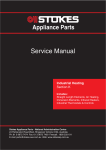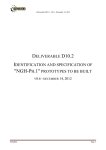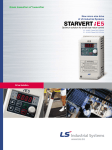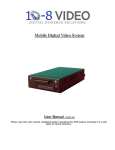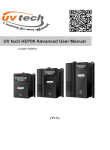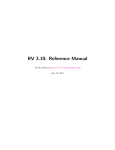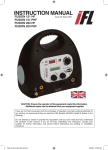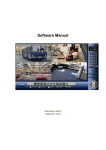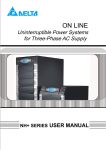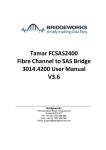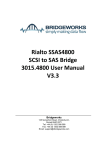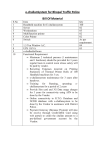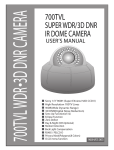Download Technical Specifications and Compliances
Transcript
Technical Specifications and Compliances 1 FIXED IP OUTDOOR CAMERA The camera should be of high standards. The picture quality should be good & should be able to suit MP state environment. As many cameras will be installed at sensitive places for security of Vidhan sabha. it should be installed in such a way that they should be able to cover the areas which Security officers may want to view by all means and from anywhere. While selecting camera bidder has to take care of all the aspects of the project Bandwidth requirement Storage space, quality of the video, Alarm generation & video analytics to be done at VMS level. Complied (Yes/No) Specifications Image sensor & Minimum Effective Pixels (Resolution) or better Electronic Shutter Min illumination/ light sensitivity (Colour) or better Min illumination/ light sensitivity (B/W) Wide Dynamic Range Backlight Compensation IRIS Control Focus Automatic Gain Control Colour, Brightness, Contrast Frame Rate Varifocal Lens Video Day and functionality IR illuminator Video Resolution Video Streams Intelligent Video 1/2.8” or better CMOS Progressive Scan & Minimum 2.5 MP or better 1/30 to 1 / 10,000 s or better Minimum 0.4lux (30 IRE, F 1.2) or better Minimum 0.02 lux (30 IRE, F 1.2) or better Required ON/OFF DC or Automatic Automatic / Manual Auto / Manual functionality Required 25 FPS for 1920 x 1080 at H2.64 Compression or better 8– 50 /(3-9)mm varifocal lens or better Motorized Focal Zoom (MFZ) Night Automatic, Color, Mono Illuminator may be Internal or external & visibility should be at least 30 m Minimum 2 MP (1920 x 1080) Individually configurable 02 video streams (H.264, MJPEG) Motion detection, Object Detection, Tampering Alert, Face Detection Compression Dual H.264 (Recording Required & Viewing) Audio Audio support Audio Compression Two-way audio Input / Output Network & Interface Interface Upgrade Network Protocols support Alarm Event Required Minimum G.711 or better AAC48KHz or better Required and should be audible. 01 IN & 01 OUT RJ-45 for 10/100 base-T Ethernet Through web browser , online, firmware upgrade TCP/IP, HTTPS, , DHCP, UDP, DNS, SMTP, RTP, RTSP, SNMP, SSL protocols/Should meet all functional requirement of the project Events / alerts send via FTP, HTTPS, email, Pre-Post alarm video buffering.. camera shall provide Camera Tamper Alarm and Motion detection as standard feature, Crowd detection 1 potential Free 1 In & 1 Out ONVIF 2 or better Alarm I/O Compliance Security Password Protection HTTPS encryption IEEE 802.1X Required Required Required IP address filtering Required General Operational temperature °C Humidity IP rating Power Certifications Local Storage SD card Camera Applications 0°C to 60 °C 0 to 80% RH non-condensing IP66/ NEMA 4X Rated Outdoor Housing with heater & Fan PoE (Up to 15.4 Watt) OR eAC24V/ DC12V, 100- 230VAC CE, UL, EN, FCC, ROHS Camera shall be able to support SD card up to 32 GB. In the event of failure of connectivity to the central server the camera shall record video locally on the SD card automatically. After the connectivity is restored these recordings shall be automatically merged or can be merged manually as & when required with the server recording such that no manual intervention is required to transfer the SD card based recordings to server. Camera shall have capability to run customised applications on the camera such as Audio Analytics, Video analytics. These applications shall be configurable and user shall have control on what applications can be run on a camera. These application changes shall not require any hardware changes in the camera. Page 2 of 30 2 FIXED IP INDOOR CAMERA Complied (Yes/No) Specifications Image sensor & Minimum Effective Pixels (Resolution) or better Electronic Shutter Min illumination/ light sensitivity (Colour) or better Min illumination/ light sensitivity (B/W) Wide Dynamic Range Backlight Compensation IRIS Control Focus Automatic Gain Control Colour, Brightness, Contrast Frame Rate Varifocal Lens Video Day and functionality IR illuminator Compression Dual H.264 (Recording & Viewing) Audio Audio support Audio Compression Two-way audio Input / Output Network & Interface Interface Upgrade Network Protocols support Alarm I/O 1/30 to 1 / 10,000 s or better Minimum 0.4lux (30 IRE, F 1.2) or better Minimum 0.02 lux (30 IRE, F 1.2) or better Required ON/OFF DC or Automatic Automatic / Manual Auto / Manual functionality Required 25 FPS for 1920 x 1080 at H2.64 Compression or better 8– 50 /(3-9)mm varifocal lens or better Motorized Focal Zoom (MFZ) Night Automatic, Color, Mono Video Resolution Video Streams Intelligent Video Alarm Event 1/2.8” or better CMOS Progressive Scan & Minimum 2.5 MP or better Illuminator may be Internal or external & visibility should be at least 30 m Minimum 2 MP (1920 x 1080) Individually configurable 02 video streams (H.264, MJPEG) Motion detection, Object Detection, Tampering Alert, Face Detection Required Required and should be audible. Minimum G.711 or better AAC48KHz or better Required 01 IN & 01 OUT RJ-45 for 10/100 base-T Ethernet Through web browser , online, firmware upgrade TCP/IP, HTTPS, , DHCP, UDP, DNS, SMTP, RTP, RTSP, SNMP, SSL protocols/Should meet all functional requirement of the project Events / alerts send via FTP, HTTPS, email, Pre-Post alarm video buffering.. camera shall provide Camera Tamper Alarm and Motion detection as standard feature, Crowd detection 1 potential Free 1 In & 1 Out Page 3 of 30 Compliance Security Password Protection HTTPS encryption IEEE 802.1X Required Required Required IP address filtering Required General Operational temperature °C Humidity Power Certifications Local Storage SD card Camera Applications ONVIF 2 or better 0°C to 60 °C 0 to 80% RH non-condensing PoE (Up to 15.4 Watt) OR eAC24V/ DC12V, 100- 230VAC CE, UL, EN, FCC, ROHS Camera shall be able to support SD card up to 32 GB. In the event of failure of connectivity to the central server the camera shall record video locally on the SD card automatically. After the connectivity is restored these recordings shall be automatically merged or can be merged manually as & when required with the server recording such that no manual intervention is required to transfer the SD card based recordings to server. Camera shall have capability to run customised applications on the camera such as Audio Analytics, Video analytics. These applications shall be configurable and user shall have control on what applications can be run on a camera. These application changes shall not require any hardware changes in the camera. Page 4 of 30 3 PTZ IP CAMERA Specifications Image sensor & Minimum Effective Pixels (Resolution) Focal Length Zoom Electronic Shutter Min illumination/ light sensitivity(Colour) Min illumination/ light sensitivity (B/W) Wide Dynamic Range Backlight Compensation IRIS Control Focus Automatic Gain Control Colour, Brightness, Contrast functionality Frame Rate Video Day and Night functionality Video Resolution IR illuminator Video Streams Intelligent Video Electronic Image Stabilization PTZ Function PAN TILT Range PAN TILT Speed Presets Tour & Pattern Privacy Mask Compression MJPEG H.264 Audio Audio support Audio Compression Two-way audio Input / Output Network & Interface Interface Upgrade Network Protocols support Alarm Event Alarm Compliance 1 / 2.8”or better CMOS Progressive Scan minimum 2 MP 4.7 to 94mm 20x Optical or better and 12 X digital Zoom 1/30 to 1 / 10,000 s 0.7 lux (30 IRE, F 1.6) or better 0.1 lux (30 IRE, F 1.6) or better Required ON/OFF DC or Automatic Automatic and Manual Auto / Manual Required 25 FPS for 1920 x 1080 or better Automatic, Colour, Mono Should automatically switch to night vision by sensing illumination level 2 MP (1920 x 1080) or better External Illuminator & visibility should be at least 50 m Individually configurable 02 video streams (H.264, MJPEG) Motion detection Required 360° continuous pan & 180° tilt range 280° / sec for panning & 160° / sec for tilting 100 Preset Points Auto tour configurable scan 04 Zones Required Required Required G.711 or better Required 01 IN & 01 OUT RJ-45 for 10/100 base-T Ethernet Through web browser , online, firmware upgrade TCP/IP, HTTPS, DHCP, UDP, DNS, SMTP, RTP, RTSP, SNMP, SSL protocols Events / alerts send via FTP, HTTPS, email, Pre-Post alarm video buffering. Tamper Alarm ONVIF 2.0 or higher Page 5 of 30 Security Password Protection HTTPS encryption IEEE 802.1X Required Required Required IP address filtering Required General Operational temperature °C Humidity IP rating Power Certifications Local Storage SD card 0°C to 55 °C 0 to 80% RH non-condensing IP66 / NEMA 4X Rated Outdoor Housing (Not required for Indoor Camers) PoE (Up to 20W), AC/DC24V/ 100- 230VAC CE, UL, EN, FCC, ROHS Camera shall be able to support SD card up to 32 GB. In the event of failure of connectivity to the central server the camera shall record video locally on the SD card automatically. After the connectivity is restored these recordings shall be automatically merged with the server recording such that no manual intervention is required to transfer the SD card based recordings to server. Page 6 of 30 4 NETWORK SWITCHES 4.1 POE ACCESS SWITCH These switches will be required for connecting cameras to the network. Item Minimum Required Specifications 1 19” Rack Mountable stackable switch with min 24 Nos. 10/100/1000BaseT PoE ports and Min.2 Nos. free mini SFP/GBIC slot to accommodate 1000BaseSx/1000BaseLx Ports Switch should support for minimum 50 Gbps of throughout & 60 mbps forwarding rate The switch should have dedicated stacking port separate from uplink ports with 50 Gbps of stacking bandwidth. Shall support POE on all 24 # 10/100/1000 ports with support for external/internal redundant power supply The switch should have IPV4 & IPv6 support from day one 2 3 4 5 6 7 8 9 10 4.2 S.no Complied (Yes/no) Switch shall support IEEE 802.3ad Link Aggregation Control Protocol (LACP) with up to 8 links (ports) per trunk. It shall support IEEE 802.1s Multiple Spanning Tree Protocol and provide legacy support for IEEE 802.1d STP and IEEE 802.1w RSTP or equivalent technology and static routes. Switch should support minimum 8000 MAC address per switch Switch should have feature to protect access ports using port security, TACACS+, Radius, storm control, Access Control List both port , vlan based. Switch should support queuing as per IEEE 802.1P standard on all ports with mechanism for traffic shaping and rate limiting features for specified Host, network, Applications etc. L3 NETWORK SWITCH 1 Layer-3 Switch. 19” Rack Mountable with minimum 12 no of 10G SFP (SX based) & 12 no of 1GE ports. All ports should work on line rate. 2 1+1 Redundant and hot swappable, load sharing Power supply & redundant FAN 3 4 5 Complied (Yes/no) Minimum required specifications Two core switches will be connected in 100% redundancy with support for active/active configuration to avoid single point of failure in network. The Switch Should support at least 250 Gbps of switching capacity with 100 mbps of forwarding rate for both IPv4 & IPv6 from day one. The switch should support 48K IPv4 and IPv6 unicast routes, 15K multicast routes, 48K MAC address and 20k ACL Page 7 of 30 6 The Switch Should support IEEE 802.1D Spanning Tree Protocol, IEEE 802.1w Rapid Reconfiguration of Spanning Tree, IEEE 802.1s Multiple VLAN Instances of Spanning Tree, IEEE 802.3ad LACP, IEEE 802.1p CoS Prioritization, IEEE 802.1Q VLAN, IEEE 802.1X User Authentication 7 The Switch Should support MLD Snooping for IPv6 in hardware, Unicast Reverse Path Forwarding for IPv6 in hardware 8 The Switch Should support Internet Group Management Protocol (IGMP) Snooping, IPv6 Multicast Listen Discovery (MLD), Multicast Listen Discovery snooping, IEEE 802.1AB LLDP 9 The Switch should have OSPF, RIP, Policy-Based Routing, BGP enabled for both IPv4 & IPv6 from day one 10 The Switch Should support Unicast Reverse Path Forwarding (Unicast RPF, support distributed and customized approach to event detection and recover, Dynamic Host Control Protocol server (DHCP) 11 The switch should support IPv6 RA-Guard, DHCP-Guard, Source-Guard features and IPv6 fast-hop security 4.3 FC-IP SWITCH (IF REQUIRED) Sr.NO Item Description --FC-IP Router /Switch 1 Minimum 18 port 2 / 4/8 /16 Gbps FC ports scalable to 36 FC ports with SFPs within the same switch with multiprotocol support for Fiber Channel (FC), FC over Ethernet (FCoE), FCIP, iSCSI, Two Fixed 1/10 Gbps Ethernet ports for FCIP and iSCSI connectivity to industry standard Ethernet switches/Routers Four Fixed 10 Gbps FCOE ports with SFPs connectivity to industry standard FCOE switches Remote SAN extension with high-performance FCIP (Fiber Channel over IP) for business continuance / DR Replication iSCSI router / Gateway capability to extend SAN storage with block access to Ethernet-attached servers. Should support backup, remote replication, and other disaster-recovery services over WAN distances using open-standards FCIP Should have hardware-based compression, hardware-based encryption, FCIP write acceleration, and FCIP tape read and write acceleration. Support for virtual Inter-Switch Link (ISL) connections should be supported on the 2 Gigabit Ethernet port through tunneling Should support Virtual SAN / Virtual Fabric and should support inter VSAN/Fabric routing Should support QoS which Can be used to manage bandwidth and control latency, to prioritize critical traffic. Diagnostic and Troubleshooting tools 2 3 4 5 6 7 8 9 10 11 Compliance (Yes/No) Page 8 of 30 12 13 Online diagnostics, Fabric Analyzer, Online system health, Port-level statistics, Real-Time Protocol (RTP) debug Dual power supply should be provided from day one Page 9 of 30 5 NETWORK BANDWIDTH The successful bidder has to provide end to end connectivity from all field cameras to Control room. The connectivity should be wired / optical fiber connectivity. The cable has to be laid by the bidder preferably underground in conduit. The bidder shall contact the Bhopal police on specified date to visit the site, view the locations of cameras to be installed and assess network / UPS cabling plan before bidding. The Network Plan shall be submitted by the successful bidder to the Bhopal Police. 1) The bandwidth from cameras to Control room connectivity should be of minimum 500 Mbps from day one & capable to scalable up to 1GBps as and when required. 2) The TTL should be always less than or equal to 10ms from field cameras to Control room. Item Media Media converters Redundancy Complied (Yes/No) Description Must be on fiber/Ethernet or wireless media with the SLA of 99.50% uptime In case of fiber, the same should be converted to Ethernet media. SLA of 99.50% uptime will be applicable on all accessories in such case The will be connected through 50 Mbps ring network with redundant network. There should not be any single point of failure. Control room to The ping or trace result from Control room to camera should be <10ms or field camera =10ms Reachability Delay, Jitter, There should not be any delay, jitter & packet drop in the path Packet loss Vendor should ensure proactive monitoring of the bandwidth and must inform MPP within 5 minutes of any fault detected in the bandwidth. In case Proactive of any unusual observations like high or low traffic pattern bandwidth usage Monitoring compared to routine bandwidth usage, packet loss, etc.; then it must be brought to the notice of concern person at customer end. Weekly reports should be submitted towards 99.50% uptime of bandwidth Reports on the first day of each week. Page 10 of 30 6 CAMERA POLES/TOWERS Camera poles should be used as and when required. The bidder based on site survey will be at a liberty to decide type of Pole/Tower to be erected at the site keeping Industry leading practice in mind. Sr. No. Parameter 1 Pole Type 2 Height 3 Pole Diameter 4 Bottom base plate Mounting facilities Foundation 5 6 7 8 Protection Sign-Board and Number Plate Minimum Specifications Complied (Yes/No) Hot Dip Galvanized after fabrication with silver coating of 86 micron as per IS:2629; Fabrication in accordance with IS-2713(1980) 6 meter or higher, as per requirements for different types of cameras & Site conditions Minimum 10 cm diameter pole(Bidder to choose larger diameter for higher height) Minimum base plate of size; 300MM x 300MM x 15 MM To mount CCTV cameras, switch, etc. Casting of civil foundation with foundation bolts, to ensure vibration free erection (basic aim is to ensure that video feed quality is not impacted due to winds in different climatic conditions and also from vibration caused due to heavy vehicles on road). Expected foundation depth of min. 100 cms Lightning arrestors with proper grounding A sign board describing words such as “this area is under surveillance” and with serial number of the pole Note: Pole shall be capable of mounting the weather proof IP rated enclosure which houses the switch, router, power supply/UPS etc… Page 11 of 30 7 STORAGE S.N. Feature Required Product Specifications Complied (Yes/No) 1 High Availability & Scale-Out Architecture 2 Scalability and Storage Operating System 3 Host Connectivity, Protocol & host OS support 4 Total Aggregate Storage Bandwidth 5 Storage Controller Processor & Cache 6 No Single Point of Failure, self-healing design protects against disk or node failure including storage backend failover. Truly distributed, clustered architecture that combines modular storage nodes with Storage systems and management software. The same storage system should scalable up to 4 times of current usable disk space Storage file system which is fully distributed, The OS should be Real time optimized storage OS. It should not be general purpose OS The offered Storage shall be supplied with at least 16nos of 10G IP Ports across multiple Controllers for Host Connectivity. There should be enough room for expansion for the same. The Storage System should support all necessary protocols which will be used in this project along with SNMP LDAP SMB1, SMB2, NFSv3, NFSv4, SNMP, LDAP, ADS, NIS, HTTP, FTP, Hadoop. Should support all latest version of Windows, Linux, UNIX The Proposed storage system should ensure a minimum total aggregate bandwidth of 10000Mbps on a 90% write & 10% read application environment. Storage OEM should provide certification for the same. Every controller should have the Latest Intel Quad Core Processor or equivalent. 24GB Cache per controller and the overall Storage system should have 130GB of cache with further scope to scale. The Proposed Storage Array should be configured with Minimum 120 TB Usable Capacity using minimum 7200 rpm speed or better Drives protected by Double disk failure or RAID6 or equivalent. The usable capacity is defined as the Net storage capacity Storage Capacity available for the application stack, after deducting the Requirements with penalties imposed by storage infrastructure requirements, disk and array formatting, RAID penalties, host OS and Disk Protection file system formatting including overheads or any other penalties which eat away usable disk space. Drives offered for the above capacity can be of the Highest Capacity offered by the Vendor. The same Storage System should support 4 times extra growth in terms of performance and capacity for future Page 12 of 30 expansion. 7 Storage Management Software Web-accessible Configuration and Management with online upgrades. Note: The storage capacity mentioned in table above is a tentative figure for specified number of cameras 80, assuming recording for 30 days (24 X 7). The bidder may suggest changes in calculation of storage based on the technical specification of camera equipment proposed in this tender. Page 13 of 30 8 VIDEO MANAGEMENT SOFTWARE Scalability: The proposed video management system shall be able to support up to 1000 CCTV Camera at to accommodate any future expansion System shall support viewing of video from multiple locations and by multiple users. Auto-Merge Recording: The CCTV camera shall support local storage. In the event of the camera loosing connectivity with the central servers, the camera shall automatically start recording on the local storage. Once the connectivity with the central server is restored, these local recordings shall be automatically merged with the server based recordings. Thus it will offer the operator continuous recording. All this functionality shall be automatically managed by the camera and the video management system. Virtualization: The proposed Video management system shall support running of the recording, management and database servers in a virtualized environment, thus lowering the requirement of physical servers. Redundancy: One Redundant recording server shall be provided for. Each recording server shall be limited to a maximum of 200 Mb traffic and shall provide sufficient spare capacity. These servers shall not be overloaded. The system shall support automatic failover for recording servers. The allocation of Cameras to recording servers shall be done automatically by the VMS. In future, Proposed system shall provide seamless integration capabilities with Automatic Number Plate recognition system, Emergency communication system. As the requirement of camera specifies Audio Inputs and Outputs on the camera, it shall be possible to have 2 way communications from the location of the camera to the central viewing / monitoring station. The video management system shall be able to trace the path of video traffic from camera to the servers with additional information providing probable bottlenecks, network issues and other transport problems affecting the transmission of video from camera to server. The software OEM should have its own development Centre in India. The VMS & the IP cameras should be from single OEM or the VMS OEM should certify the IP cameras proposed. VMS shall support video streams up to at least 15 Frames per Second Sr.No Specifications Complied (Yes/No) The system should be easy to install, learn, operate and manage: 1. The VMS must have rich user interface that provides one-click access, dragdrop, context menu, shortcut keys, customizable GUI etc. to enhance operational efficiently in daily tasks and maintain The VMS shall have ability to respond fast & shall be applicable to all processes, functions, features, and screens of a video management system. 2. Simple, clear documentation including User Guides (how to use the product) and Technical Reference Manuals (quick reference on functions and procedures) shall be submitted Page 14 of 30 Scalability: The VMS shall have ability to connect and integrate other 3. 4. 5. 6. 9. technologies and third party software systems (e.g. ANPR, RLVD) in future and act as a cohesive platform for entire surveillance and security system. The system should be able to bi-directionally and dynamically exchange data between various software applications in real-time as well as schedule transfer. The Software shall be scalable upto 10 times minimum. Support for unlimited cameras, servers, sites and clients. Support for storage expandability. Well documented Software Development Kit (SDK): The SDK should include a rich, easy-to-use Application Programming Interface (API) that supports the most common programming languages. Input and output support: The VMS shall have ability to receive and accumulate inputs from external hardware/software and respond and activate outputs based on the predefined rules. Event management: The VMS shall have ability to enforce custom settings for event detection, alarm notification, recording, input/out (I/O) control, and other features in response to events. The alarm management module shall support graphical displays with interactive icons to display the status of the cameras & other inputs. Support for standard protocols: The VMS shall have ability to maintain independence from any one vendor & shall support open standard protocol i.e. ONVIF Smooth software upgrade path for support of new devices, drivers and operating systems. System should be able to implement software upgrades without requiring all hardware components to be reconfigured. System should provide Database Server Redundancy options, Camera Server Redundancy options, and automatic fault tolerance for robust system uptime and Distributed database and video storage. The system should be able to define critical cameras and provision to record critical cameras over others. On screen help and instructions: The system should provide context-sensitive help and active assistance based on the module / screen / operations a user is trying view or perform. As the user moves around the interface, the help should automatically changes to the relevant field-level help topic. User management with user groups, roles, privileges and access policies (assigned views, PTZ priority, and access to video wall etc.) Recording Server : • The System shall not restrict the number of recording servers • Shall support dual streaming • Shall allow each stream to be viewed independently by client viewer. • Recording from connected cameras shall be stored in individual databases. • Shall support multiple storage formats • Shall support recording in all resolution at desired FPS • Shall support audio recording 10. The VMS shall have ability to push a single command or configuration to multiple users with a single “Click”. This can be done though a GUI where access privileges and other parameters can be applied to multiple users or user-groups. 12. Configurable data aging mechanism to automatically compress older recordings in lower frame rates to enhance storage. Page 15 of 30 14. 15. 16. Customizable recording retention period for specific camera, group, area etc. Remote Users : Should support at least 10 remote users via network/web browser/client software Automatic check & update of hardware drivers & firmware free of cost The VMS shall support Electronic Image Stabilization feature 19. The VMS shall have ability to easily install, configure, modify, search and remove surveillance devices with automatic discovery of IP devices. 20. Advanced option to install other devices like Analog cameras, encoders, microphone-speakers. 21. The VMS shall have ability to logically group devices based on installation location, device type, configuration type or any other predefined rules. Individual cameras/devices should inherited rules from parent group/subgroup. 22. The VMS shall have ability to search and view device(s) based on standard criteria like ID, Name, Location, Group, Type etc. 23. 24. 25. 26. 27. 28. The VMS shall have ability to enforce access privileges (View /Add /Edit/ Remove) to device(s) or group(s). The VMS shall have ability to draw and configure e-map of surveillance facility, choose back-ground images, User-definable symbols (for deployed devices)and programmable functions, e.g. hyperlinks, controlling video feed, initialing alarms etc. Remote firmware updates notifications and wizard driven installation. Provision for primary and backup storage settings for individual camera feeds. The VMS shall have ability to configure multiple streams with different quality parameters e.g. Codec (H.264, MPEG, JEPG) , resolution, frame & bit rate etc. Support for full duplex audio 29 a) The VMS shall have ability to create and assign pre-configured views/layouts for monitoring including features like: b) Linking dynamic Webpages, images, maps a view, c) Sharing a view between users, d) Special views for widescreen monitors, e) Updating a view only on motion detection, f) Rotating live video from a pool of cameras, g) Assigning different quality attributes on-the-fly, based on operator’s actions. E.g. different quality settings for selected and non-selected video feeds/tiles/panes. h) Granting or revoking permission to use the view etc. 31. Basic recording options [Full, Scheduled recoding , Motion detection recording, external/internal hardware or software events / trigger based recording] 32. Advanced recordings options [Video only, Audio only, Video plus Audio, Retention rules, Archive/back-up rules, and storage limits etc.] 33. 34. The VMS shall have ability to configure, store and track both pre- and post-event recordings. The pre-post event time should be configurable. PTZ configuration including presets, patterns, patrolling, masking, priority and permissions. Page 16 of 30 35. The VMS shall have ability to support operations from Web client, Windows Client, and Mobile devices etc. Popup display on the screen in case of any event/alarm/threshold etc. 37. Multiple monitor support: The system should allow connecting multiple monitors on single client workstation (loaded with suitable graphics card) and display different contents on each of the connected monitor. 38. All panes / tiles should indicate mode (live or recoded), source (camera name/location) and date/time and applied quality information (FPS, CODEC). The font color shall be changed automatically in sync with the video/image to have a clear text reading at any point of time. A matrix view should support minimum 2x2, 3x3, 4x4…9x9 formats and any number of multiple screen divisions. 39. PTZ controls: When PTZ is deployed and enabled, system should offer a separate control panel for PTZ operations. The control panel should include list of presets, patterns, tours, eight directional & home positions and zoom-in & zoom-out buttons. A dedicated joystick can also be used for PTZ operations. 40. 41. 43. 44. 45. 46. 47. 48. 49. PC keyboard shortcut keys: Along with menu-driven interface, a VMS should also support custom shortcut keys to helps operators quickly switch between different modules/screens, change views or panes/tiles and to carry out playback functions. Snapshots: System should allow creating a still image from live or recorded feed and storing it into a workstation. The VMS shall have ability to boost video quality manually (by operators) or automatically as configured on event trigger or as scheduled. Instant replay facility with configurable replay-duration. The VMS shall have ability to bookmark / add-to-favorites in both live and playback modes. Bookmarks should be user specific and managed (create, share with other users, search, remove, add comment) by the owner. Digital zoom to enlarge portion of an image to provide superior zooming capability. The VMS shall have ability to Start/Stop Recording on demand (manually) Option to view surrounding cameras: The system should enable operators to select master camera feed and based on group/subgroup details, its surrounding cameras should be automatically displayed on separate panes. These panes/tiles should be dynamically generated so that operator does not need to manually pull the feeds from desired cameras. Evidence export feature: The system should allow users to export audio/video evidences in open format for internal investigation or to share authentic proof to public authorities and outside agencies. Alternatively the bidder may provide the required player/software to run the exported video file if the VMS not support to export in avi or other standard format. The system should offer options to enable watermarking camera name & timestamp and also encrypt or apply password protection to the exported clips. Page 17 of 30 50. 51. 52. The VMS shall have ability to quickly search and retrieve recordings: Search methods should include search by camera(s), group, date/time, alarm/event / bookmark list, smart (motion) search by creating motion index or by generating thumbnail summary of a video archive to locate specific event. The search result should provide an intuitive timeline browser that represents the overall length of the recording. It should underscore recoded event (motion based, scheduled, event based or normal) and allow users to quickly jump back and forth to a location in selected recording. Smart (motion) Search: The feature should enable users to select area of interest on any given view of camera recording, and search for motion incidents within that area The VMS should have onscreen process guidance/help menu & instruction The system should offer following playback controls • Play/Pause • Lock speed • Forward playback (1x, 2x, 4x, 10x, 20x, 40x,… • Reverse playback (-1x, -2x, -4x, -10x, -20x,-40x, ….. • Slow forward playback (frame by frame, 1/8x, 1/4x,1/3x, 1/2x, 1x) • Slow reverse playback 53. Video Lock: The system should allow users to lock the relevant portion of video recording related to any event to avoid the deletion of the important incidence from the system before its retained/backed-up. 54. Evidence Printing: Option to create and print a small surveillance report that includes image(s) and comments about recorded incident. 55. 56. 57. 58 The system should enable users to send/transfer a view to preconfigured displays. The system should offer options to set Hue, Saturation, Brightness, Contrast, Sharpness etc. The system should have in-built, configurable, basic motion detection analytic engine that efficiently • Detects motion • Virtual line • Auto tracking The system should have in-built event/alarm management module that allows generating, distributing, storing, tracking and reporting of incidents and events as they occur. The module should have The VMS shall have ability to: • Define and configure events that can be triggered by motion detection analytics, video loss, audio detection, active tampering, temperature, connected external devices or by manually activating the same. • Configure automatic/programmed responses based on priority and escalation level for specific event(s). • Search and view list of triggered events based on source, priority, event type, date/time, keyword etc. Page 18 of 30 59. The system should provide interactive reporting interface with standard and userdefined custom reports and filtering options to: • Monitor real-time and history of overall operational health of a surveillance system or individual components (recordings, cameras, servers, storages, CPU, memory, bandwidth etc.). • Review currently logged in users and functions being performed. • Retrieve audit trails - user activities, errors and system logs. • View list of hardware units and selected configuration options. • List down configured users and corresponding roles & permissions. • View details of bookmarks, event/alarm history and exported evidences 60. The system should have Inbuilt diagnostic utility that constantly monitors several different functions of deployed hardware and software modules and attempts to correct the problem in case of deviations from the established baselines occurs. 61. The facility should be there to extract & save the video footages / images on CD, DVD, USB, External Storage etc. Page 19 of 30 9 DESKTOP S .No. Particulars 1 Processor 2 3 Chipset Memory 4 5 6 7 Hard Disk Slots Motherboard Graphics 8 Audio 9 Ethernet 10 Ports 11 12 Optical Drive Chassis 13 14 Power Supply Keyboard & Mouse 15 Display 16 Others 17 OS/Software Support Specifications Compliance (Yes/ No) Minimum 4 core processor with minimum 3.0 GHZ Minimum 6MB of L2/L3 Cache. AMD 780V /Intel Q33 or better 2x2GB Dual Channel DDRII SDRAM 800 MHz or higher expandable to 8 GB 1 TB SATA II HDD 3Gbits/s with NCQ & 7200 RPM Minimum 1 PCI slots and one PCI Express x16 bus slot Motherboard shell be of Micro ATX / smaller form factor Integrated graphics controller Should be able to support 3 monitors Integrated audio controller (Intel high definition or equivalent) Integrated PCI 10/100/1000 Mbps Ethernet controller with full duplex & WOL support • Integrated Two port SATA 3.0 Gbits/s controller • 1x fast serial port, minimum 4 x USB 2.0 ports (2 ports on front ) • 1xKeyboard port • 1xMouse port • 1xR45 port 16X or Higher Speed DVD‐ROM drive Slim Chassis (Small form factor) with enough cooling fans, one free internal peripheral bay and 240W Micro ATX / SFF Power Supply. • 104 keys OEM Keyboard with bilingual support & Key Skin Cove • OEM Optical Scroll Mouse with Mouse pad • 21” TFT LCD Flat Monitor with 8 ms or better response time, TCO ‘99/03 compliant • 29” TFT LCD Flat Monitor with 8 ms or better response time, TCO ‘99/03 compliant for Supervisor one per location. • Should support upto 3 monitors connected to one CPU • Power management features & Desktop Management Interface (DMI) implementation • System user manual and all other necessary accessories • Preloaded OS Software: Windows 7 or Windows 8 or better Page 20 of 30 Page 21 of 30 10 USB JOYSTICK S .No. Particulars 1 Basic Design 2 Device Support 3 Software Support 4 5 6 7 8 Switches and ports Storage Temperature Humidity Compliance Power Supply required Specifications Compliance (Yes/ No) The joystick shall be USB with Hall Effect specifically designed to provide the network video controlling with responsive and accurate pan/tilt/zoom camera positioning controls. The device shall support the camera makes mentioned in the RFP Can be integrated seamlessly with any video surveillance software platform recognizing joystick inputs via Microsoft's DirectX. Six programmable switches and USB Port 0° to 50°C 0 to 85% RoHS Compliance +5VD Page 22 of 30 11 SERVER Processor 2 processors of Intel Xeon Processor E5 V2 family or above Minimum Number of Cores Minimum Clock Speed: Minimum L3 Cache: Memory Disk Controller Hard Disk Drive: Network Interface: DVD Writer External Interface Disk Bays: Power Supply Fans Graphics Controller OS Environment Products RDBMS Licensing Form Factor & accessories 10 2.80 Ghz 15 MB Each server should be configured with 64 GB of memory The server should have at least 24 DIMM slots and a maximum scalability of up to 700 GB Integrated SAS Controllers The server should support a minimum of 2 hot plug SAS, SATA and SSD hard disk drives & be supplied with 4.0 TB through hot swap SATA / SAS HDD Minimum 4 x 1 GB SATA DVD‐ROM ‐ R/W or DVD ROM. The server should provide a minimum of 2 x 10Gb ports for Ethernet and 2 x 8 Gb ports for FC. Or The server should provide minimum 4 x 10Gb CNA (Converged Network Adaptor) ports. Minimum 5 hot‐swap SAS HDD 94% or more efficient 2 nos Hot Plug Redundant power supplies must sustain full load . Hot‐plug fans, at least 1+1 redundancy Integrated Graphic Controller with external VGA port and minimum 16MB Video RAM and 1280x1 024 resolution Suitable server license for VMS application handling 80 Cameras The server must be compliant with following international standards: PCIE 3.0 Compliant, Microsoft® Logo certifications, ACPI 2.0. Compliant, UL/FCC certified Suitable RDBMS for VMS application ‐ Oraclel10g/11g/SQL‐2012 or equivalent 80 clients. Should include all necessary licenses for management for a fully loaded server having 80 clients Rack with Cable Arm Guard, Power Distribution Unit and all mounting and equipment Inbuilt / integrated / installed with KVM switch and appropriate TFT Digital Color Monitor TCO certified, USB Keyboard & mouse to Monitor all the Servers. KVM should be compatible with all OS, should have On‐Screen Configuration and Activity Reporting displays system‐related Page 23 of 30 Gartner report information on the console monitor, such as selected server name, status, power‐up test data and configuration menus. Server Should be in the in the list of top 5 server brands as per Gartner report published for India/Asia Pacific/World in the year 2013 12 WORKSTATION The Successful bidder has to provide furniture for the control room workstations, sitting arrangement & other requirement as per industry standards. Sample has to be approved by the purchaser. The bidder has to ensure industry leading practices are kept in mind ensuring aesthetics of the room. 13 LED DISPLAY UNIT 55” Resolution 1920 x 1080 pixels, Full HD or higher Size 55 inch or bigger Light Source LED Response Time 8 ms Viewing Angle H : 178°, V : 178° NTSC, PAL, SECAM Video Standard Inputs 480i, 480p, 720p, 1080i, 1080p or better 1x Digital DVI‐I ; 1x Digital DVI‐D ; 1x CVBS BNC ; 1x Component Video BNC ; 1x BNC (RGBHV or YPbPr) Standard Outputs 1x Digital DVI‐D ; 1x CVBS BNC Control Network port (RJ45, 10BASE-T/100BASE-TX) RS-232C (D-sub 9-pin, straight) Input Voltage AC 90~240V@50/60 Hz Power Consumption < 160W Standby Mode < 2W at 110V Temperature Operating Life 0°C ‐ 35°C (32°F ‐ 95°F) > 50,000 hours Combined Bezel (Typical) Upto 6.0 mm (1 + 1) Redundant AC‐DC high‐efficiency power supply w/ PFC Power Supply Resolution output support AC Voltage 100 ‐ 240V, 50‐60Hz 1920x1200 per output minimum The Display unit should be capable of 24 x 7 operations without degradation in performance. Comprehensive 3 Years onsite warranty Page 24 of 30 14 UPS 14.1 UPS REQUIREMENTS & FEATURES UPS System design concept is based on redundancy and availability with true online system. To support the dual bus system configuration four units of UPS should be installed. Dual redundant UPS systems will take care of following needs – Servers, video wall, Storage, Workstations and cameras. Cabling needs to be done from the UPS to all respective cameras. This will be redundant to power through POE switch The solution should be automatic with power supply from the transformer as the primary source and automatic switchover to DG set as a secondary source for the control room. Earthing should be provided from the electrical room control panel to the Earthing pits. Description Specification Complied (Yes/No) 14.2 GENERAL SPECIFICATIONS UPS Topology On line double conversion VFI SS 111 Architecture of the UPS Modular, Scalable, redundant based on 6.7kVA Power Modules In/Out phase Configuration Three phase Neutral Neutral Passing through Output wave form on mains run Sinusoidal Output wave form on battery run Sinusoidal Bypass type Static and electro mechanic Transfer time Zero 14.3 INPUT Nominal Voltage 400 V three phase / 230V single phase Voltage range -20% +15% 50 Hz o 60Hz Frequency (autosensing) THDiin < 3% al 100% of nominal load Power Factor > 0.99 from 50% to 100% of nominal load 14.4 OUTPUT WITH MAINS (AC-AC) Nominal voltage 400 V three phase Nominal power 20 - 120kVA Active power 18 - 108kW Voltage variation (static) ± 1% Page 25 of 30 Voltage variation 100%; 100-0%) (dynamic 0- ± 1% THDv on nominal power (linear < 0,5 % load) THDv on nominal power (not <1% linear load P.F.=0,7) Frequency 50 Hz o 60 Hz (autosensing or selectable) Synchronized with input frequency or Frequency tolerance ± 1% free run Current Crest Factor 3:1 accordingly with IEC EN62040-3 Overload capability: 10 min 60 sec 125% load rate with no bypass intervention 150% load rate with no bypass intervention 14.5 OUTPUT IN BATTERY RUN (DC-AC) Nominal voltage 400 V three phase Nominal power 20 - 120kVA Active power 18 - 108kW Voltage variation (static) ± 1% Voltage variation 100%; 100-0%) (dynamic 0- ± 1% THDv on nominal power (linear < 0,5 % load) THDv on nominal power (not <1% linear load P.F.=0,7) Frequency 50 Hz o 60 Hz (autosensing or selectable) Frequency tolerance ± 1% free run Current Crest Factor 3:1 accordingly with IEC EN62 040-3 Overload capability: 2 min 30 sec 125% load rate with no bypass intervention 150% load rate with no bypass intervention 14.6 BATTERY Type Lead Acid, sealed, maintenance VRLA Nominal UPS Battery Voltage 252 Volt DC free Page 26 of 30 Battery charger type PWM hi efficiency, one in each power module Charging Cycle Intelligent with boost charge and advanced management Max Charging Current 2,5Aeachpower module 14.7 ENVIRONMENTAL SPECS Noise level @ 1m 50÷65 dBA Working temperature range from 0°C to +40°C Stock temperature range from -20°C to +50°C (excluded batteries) Humidity range 20-80% not condensing Protection degree IP21 14.8 MECHANICAL AND MISCELLANEOUS Net Weight without batteries 1 Dimensions (W×H×D) 2 364 kg 1 x (570 x 2080 x 912) (mm) Colour RAL 7016 Technology rectifier/booster/inverter MOSFET/IGBT Communication Interface 2 serial port RS232, 1 logic level port, 5Dry contacts port Input/output connections 3P + N + PE Connectors on omega bar Installed Power Modules 6.7kVA Standards EN/IEC 62040-1, EN/IEC620402, EN/IEC 62040-3 The UPS Manufacturer Company must have CE/ ISO9001 certification for development, production, and services. Signal referencing copper Earthing to be used using braided copper wire of 6 Gauge inside the Control room. The weight depends on the number of the installed batteries accordingly with the required autonomy. The battery cabinet dimension can change depending battery set accordingly with the required autonomy. Page 27 of 30 15 UPS FOR FIELD EQUIPMENT (IF REQUIRED) Bidder should provide 1 KVA UPS for Field equipment power backup (if power from centralized UPS is not feasible) of at least 4 Hrs. PARAMETER SPECIFICATIONS Complied (Yes/No) Capacity Technology 4200 Watts / 6000 VA or better SPWM, IGBT/MOSFET (for more than 72 DC volt IGBT preferred) Input voltage 230V AC, Single Phase, 3 wire Input Voltage Range 176V AC to 282V AC Input Frequency Range 47 /63 Hz +/- 3 Hz (auto sensing) Input Over Voltage Protection 280V AC Input Under Voltage 155V AC Protection Over Voltage cut off Should be offered externally Output voltage 230V AC Single phase ±1% Frequency 50 Hz ± 1% Lead power factor 0.7 Lag to Unity Output Over Voltage 245V AC Single Phase Protection Output Under Voltage 210V AC Single Phase Protection Over load capacity 125% of rated load for 60 sec Total Harmonic Distortion Less than 3% Short circuit protection Soft Shut down should occur without blowing any fuse Crest Factor up to 2 : 1 Over Temperature Indication Required Load on Battery Indication Required Battery on Charge Indication Required Battery low Indication Required Mains on Indication Required DC on Indication Required Inverter on Indication Required Indication Required Inverter Tripped 1. Output Over Voltage. 2. Output Low Indication Required 3. Over Load System Indication Required Static Switch Automatic Bi-directional should take care of 100% uninterrupted transfer of load from UPS Transfer Time <4 m sec Overall Efficiency >85% Inverter Efficiency >90% Metering Separate/Single Digital Meter DC Voltage Display Required DC Current Charge/discharge Display Required Output Voltage Display Required Output Current Display Required Input Voltage Display Required Page 28 of 30 Digital three/three & half freq. Display Required Meter (for Both input & output) Battery Maintenance-free sealed Lead-Acid battery with suspended electrolyte : leak proof Period of Backup 1 Hr. with 100% Load DC Bus Ripple <1% Total DC Bus Voltage As per requirement No. of Battery Banks Single No. of Battery As per requirement of 4 hrs. battery backup VAH Rating As per requirement Battery Housing Closed housing with lock Audible Alarm for Following Conditions Battery Low Audible alarm Required Mains Failure Audible alarm Required Inverter Under-voltage alarm Required Audible Inverter Over Voltage Audible alarm Required Over Temperature Audible alarm Required Inverter Overload Audible alarm Required SNMP Enabled Environmental Operating Temperature 0 - 50 °C Humidity 0 - 95% (non-condensing) Noise Level <50 dB at full Load from 1 Mtr distance Page 29 of 30 16 MULTIFUNCTIONAL PRINTER Printing Technology: Format: Printing Speed: Printing Resolution (dpi): First Page (sec): Memory (MB): Paper Feeding: Interface: Network: Duplex: Size (W x D x H mm): Power Printing (W): Others: Power Stand-by (W): Noise Level Maxim Volume (page): Laser Monochrome A4 A4 / Letter – minimum 40 ppm 600 x 600 dpi (1200 x 1200dpi equivalent) A4 / Letter - 8.6 sec Minimum 512MB 600 (Standard – 500 + Multipurpose Tray – 100) USB 2.0 10Base-T / 100Base-TX / 1000Base-T Standard (only A4 / LTR / LGL / 8.5"×13") 454 x 424 x 345 mm Approx. 660 W 5 Line LCD Operation Panel 15 W 54.5 dB or less 100000 pages Page 30 of 30






























